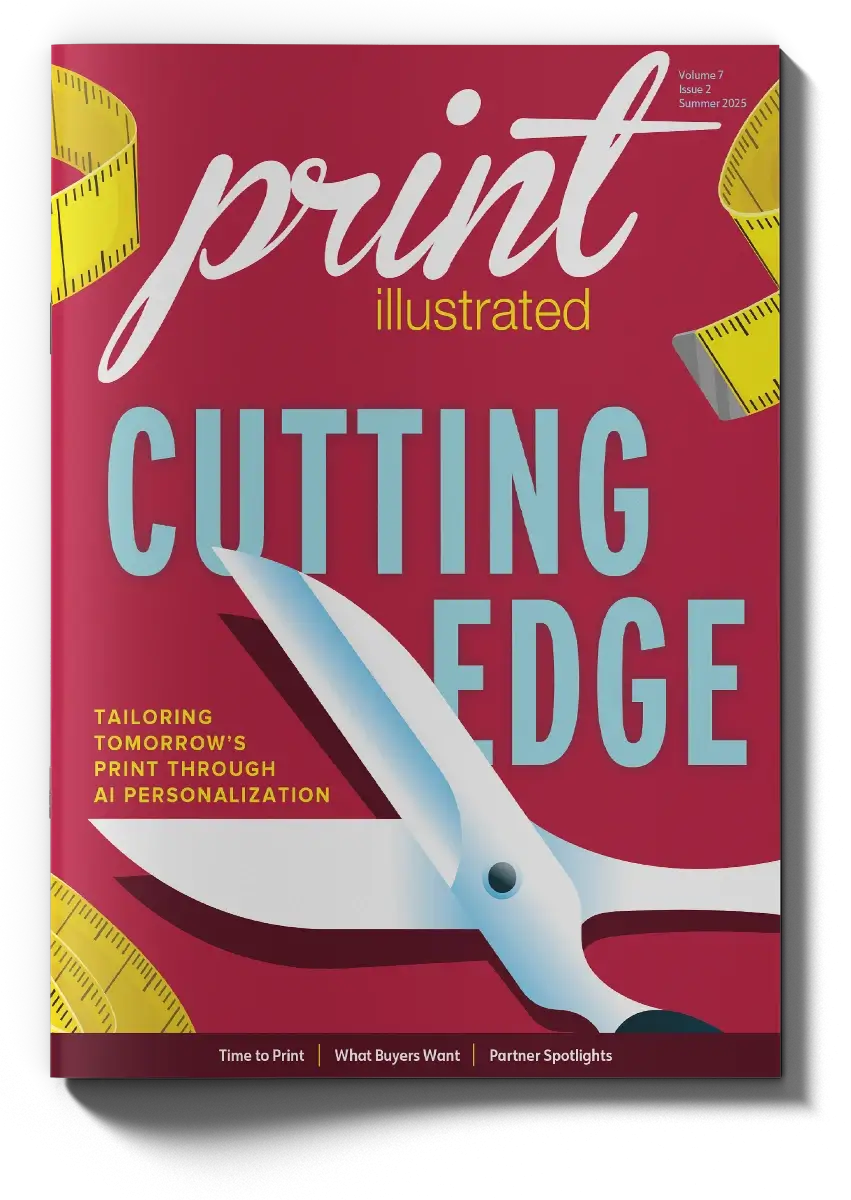Language. Tone. Imagery. In the world of artificial intelligence (AI)-powered personalization, David Klempke says these are the foundations of engagement. To truly connect with today’s customers, print companies must immerse themselves in high-quality, well-organized data.
For all of the hype and hope, AI is only as powerful as the inputs it receives. From there, success hinges on alignment—brand voice, targeting objectives, and messaging strategy all working in concert. The goal isn’t simply personalization, but personalization that’s timely, emotionally intelligent, and meaningful.
Klempke, Director of Client Marketing Technology Solutions at IWCO Direct, says this means going far beyond “Dear [First Name]” in your approach. “It means adapting language, tone and imagery to reflect real customer needs. Through multivariate testing and real-time optimization, print marketers can identify what resonates—and deploy it at scale.”
And when every touchpoint—from direct mail to email to digital—is telling the same story, personalization evolves from a tactic into a powerful, unified brand experience. That’s where the future of print is headed.
In an increasingly digital world, commercial print has a powerful opportunity to evolve by embracing AI, which for those taking the leap, is quickly becoming a transformative ally. By finding their groove, print providers are able to deliver personalized experiences that feel more human, not less.
“We always combine AI generation with human review. We validate, review, and fine-tune every element before it hits the press.”
– David Klempke, Director, Director of Client Marketing Technology Solutions, IWCO Direct
Today, as printers adapt, AI-driven personalization is redefining how brands connect with audiences—not just through data, but through meaningful, relevant, and emotionally intelligent messaging. “We’re seeing up to 39% increases in revenue and 37% reductions in cost when clients integrate AI into their campaigns,” Klempke says. “This isn’t just about personalization; it’s about competitive advantage.”
At the heart of this shift are technologies that allow marketers to analyze behavior patterns and translate insights into real-time content decisions. Dynamic content engines, predictive analytics, and machine learning models help tailor print messages to a recipient’s preferences, purchase history, or even life stage. The result: direct mail campaigns that feel personal, relevant, and timely.
Truly effective personalization doesn’t begin on the pressroom floor—it starts far earlier, with the data, strategy, and structure that inform every decision downstream. “AI is only as good as the information we give it,” Klempke says. “We start with high-quality, well-organized inputs and complement them with client-driven guidelines. The biggest challenge we face when scaling is complexity. But we’re solving that with integrated production and AI-powered automation that make high-volume personalization manageable.”
Personalization doesn’t stop at names or demographics. It goes deeper, creating storytelling arcs that feel curated for each individual. AI can test hundreds of content variations simultaneously, learning in real time which combinations drive higher engagement. This allows print campaigns to not only scale but also continuously optimize for performance.
To scale or not to scale…
Stu Heinecke, bestselling author and the thought leader some have dubbed the “Father of Contact Marketing,” says AI gives today’s marketers starkly new depth of insights at scale. Suddenly, they know what will light up the brain of anyone they want to reach.
Heinecke recommends tools like Clay.com, AgenticBrain and Trigify.ai, to identify deep personalization opportunities and real-time behavioral triggers. But he cautions against losing the human essence in the process.
“AI is a miraculous tool, but the essence of personalization is creating person-to-person connections,” Heinecke says. “Use AI to gather relevant information, but use it to craft very human experiences. If you’re sending something physical, look for ways to deliver something only humans can produce.”
Some of the campaigns Heinecke has been involved with prove the point. A notable one involved a cartoon-based drip mailer sent monthly to prospects. Each cartoon reflected personal details about the recipient, fostering a connection so strong that some recipients framed the prints.
The client, a commercial roofing contractor, grew from an $8 million firm to a $150 million industry leader. It is the kind of brand affinity that AI-driven print personalization aims to replicate at scale.
“AI is a miraculous tool, but the essence of personalization is creating person-to-person connections.”
– Bestselling author Stu Heinecke
But adopting AI at scale brings its own set of challenges. As print companies expand their capabilities, they must manage larger volumes of data, more customized content and tighter coordination between teams to keep everything running smoothly.
The solution lies in integrated systems and AI-powered automation that handle content production without compromising speed or accuracy. Additionally, a dual focus on automation and human oversight ensures campaigns remain compliant, consistent, and emotionally resonant. “We always combine AI generation with human review,” Klempke says. “We validate, review, and fine-tune every element before it hits the press.”
Beyond content creation, measurement is another crucial piece of the puzzle. AI empowers printers to track not just delivery metrics, but real engagement. “We monitor response rates, ROI, and digital lift—especially when campaigns include QR codes or personalized URLs,” Klempke says. “With AI, we can adjust mid-campaign and improve continuously.”
To get started, print companies should begin with a clear audit of current workflows, data capabilities, and content challenges. Piloting AI tools for a single campaign or workflow is often a smart way to prove value before full-scale implementation. “AI integration isn’t about replacing people,” Klempke says. “It’s about amplifying what they do best with smarter tools and better data.”
For many, that amplification leads to stronger connections and a greater sense of community around the brand. When people receive something that speaks directly to them, Klempke says they feel seen. “That sense of recognition builds trust. Over time, that trust becomes loyalty.”
As the commercial print industry navigates change, AI personalization continues to become a strategic imperative printers are leaning on, offering a path to relevance in a fragmented media landscape.
5 steps to smarter print personalization with AI
- Build your data
AI can only personalize as well as the data it receives. Ensure your customer data is up-to-date, accurate, and segmented by behavior, preferences, and life stage. - Pilot before scaling
Test AI-driven personalization on a single campaign or workflow. Measure results, refine your approach, and scale what works. - Integrate across channels
Personalized print performs best when it’s part of a cohesive journey. Align your print touchpoints with digital, email, and social to reinforce messaging. - Automate and review
Let AI handle scale and speed, but always review for tone, brand consistency, and compliance before going to press. - Track. Learn. Optimize.
Use QR codes, personalized URLs, and AI analytics to monitor real-time engagement. Adjust mid-campaign and continuously improve.

